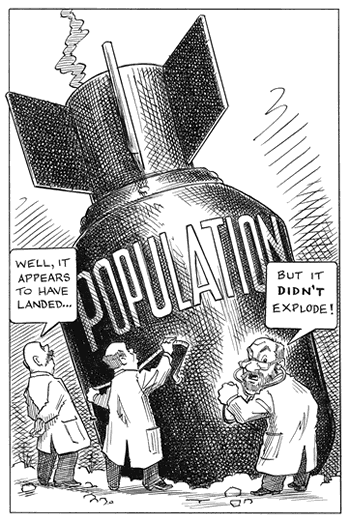- Health Care
- International Affairs
- US Foreign Policy
 |
| Illustration by Taylor Jones for the Hoover Digest.
|
While world population has doubled during the past several decades to more than 6 billion persons, birthrates in many countries have fallen to unprecedented low levels. The result is a demographic divide between nations with high and low rates of population growth that will have enormous economic and political significance.
Virtually all high-income countries, and a few poorer ones, especially China and Russia, have fertility rates that are too low to fully replace their populations. The average is only a little above one child per woman during her lifetime in Spain, Italy, Russia, and several other nations. Even in the United States, which has the highest fertility rate among rich nations, women give birth to only about two children in their lifetimes.
Birthrates are notoriously difficult to forecast, but the persistence of low fertility over several decades in so many countries and regions of the world strongly indicates that their populations will eventually fall. As a result, overall world population will grow much more slowly during the next several decades than predicted by population scaremongers.
In the recent report "World Population Prospects," UN demographers conceded after repeated denials that fertility rates below replacement levels are not a passing phenomenon. They recognized that every nation that had low birthrates during the 1980s continues to do so. They were joined in the 1990s by other countries with birthrates that dipped below replacement.
|
"The growing demographic divide between nations with high and low rates of population growth will have enormous economic and political significance." |
The picture is different in most very poor nations, including all of Africa and most of South and Central America; their much higher birthrates are causing their populations to grow rapidly. This difference in population growth between rich and poor nations will further widen the gap in per capita incomes between developed and other nations. Indeed, faster population growth in less-developed regions contributed to the considerable widening of world income inequality during the past couple of decades.
An efficient remedy for this population divide would be for many men and women in countries with low incomes and growing populations to move to those with high incomes and stable or declining populations. The recent estimates from the United Nations show that developed regions absorbed about 20 million immigrants from poorer nations during the last decade of the twentieth century. This global shift contributed about half the growth in the populations of richer nations (except Japan, which has refused to accept many immigrants, despite the prospects in that country of a rapidly falling and aging population).
Immigration to Western Europe was especially important, accounting for more than 70 percent of its population growth during the past decade. The United States absorbed almost as many immigrants as did Europe, but immigration contributed a smaller part of its growth since U.S. birthrates are higher than Europe’s. In addition, many persons entered both the United States and Europe illegally, so that the total contribution of immigration to population growth in both regions was even larger than official figures indicate.
Still greater emigration from poorer to richer nations would help alleviate the continuing inequality among the world’s economies created by the higher population growth of the less-developed world. But rich nations are reluctant to open their borders any wider to immigrants because many powerful interests and most politicians oppose large-scale immigration. Trade unions fear that competition from immigrant labor will lower wages of their members. Many taxpayers believe the welfare state attracts immigrants who mainly seek government benefits and contribute little to production. Other groups worry about the effect of immigration from Third World countries on the racial and ethnic mix of their populations.
Many of these arguments could be countered if host nations gave greater priority to younger and more skilled immigrants who work hard and who contribute much more in taxes than they receive in benefits. Even skilled immigrants are not readily welcomed, however, as seen from the political difficulties in expanding the H-1B American visa program, which gives temporary visas to high-tech personnel.
These obstacles ensure that legal immigration will not solve the conflicts that arise from different rates of population growth. The problems would be greatly reduced if poorer nations promoted greater economic growth through encouraging entrepreneurship and through greater investments in human and physical capital, for birthrates invariably fall rapidly when countries have faster economic growth and expanding education, especially for women.
Unless immigration and population policies change, conflict between the economic haves and have-nots will inevitably increase as growing numbers of young men and women from the underdeveloped world try to gain access to the opportunities in rich nations.







